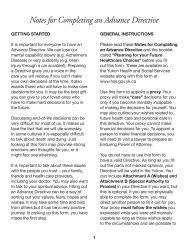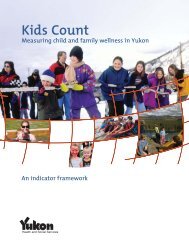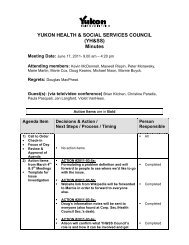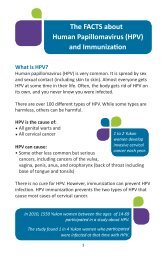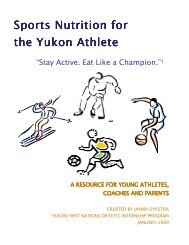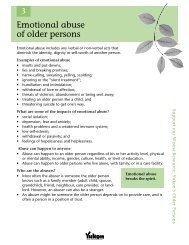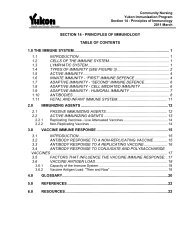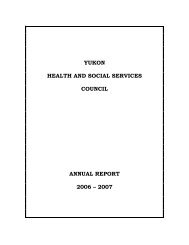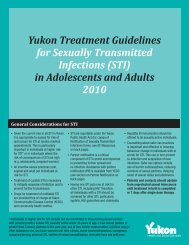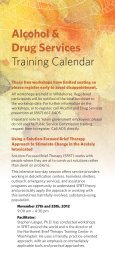Pathways to Wellness - Health and Social Services - Government of ...
Pathways to Wellness - Health and Social Services - Government of ...
Pathways to Wellness - Health and Social Services - Government of ...
Create successful ePaper yourself
Turn your PDF publications into a flip-book with our unique Google optimized e-Paper software.
● ● <br />
A background paper
Contact Us<br />
Paula Pasquali<br />
Executive Direc<strong>to</strong>r, <strong>Wellness</strong><br />
(867) 393-6305<br />
paula.pasquali@gov.yk.ca<br />
OR<br />
Jan Langford<br />
<strong>Wellness</strong> Policy Advisor<br />
(867) 667-3674<br />
jan.langford@gov.yk.ca<br />
Toll-free / long-distance<br />
1-800-661-0408, extension 6305 or 3674<br />
Website<br />
www.yukonwellness.ca<br />
Email<br />
yukonwellness@gov.yk.ca<br />
Mail / FAX<br />
<strong>Wellness</strong> Initiative, H-1<br />
<strong>Health</strong> <strong>and</strong> <strong>Social</strong> <strong>Services</strong><br />
Yukon <strong>Government</strong><br />
Box 2703, Whitehorse, Yukon Y1A 2C6<br />
Fax: (867) 667-3096<br />
Additional hardcopies <strong>of</strong> the background paper can be obtained by contacting us by phone or email.<br />
The background paper can also be downloaded from our website: www.yukonwellness.ca<br />
All pho<strong>to</strong>s © <strong>Government</strong> <strong>of</strong> Yukon
Contents<br />
Setting the stage 3<br />
What is wellness? 5<br />
How well are we? 11<br />
What influences our health? 16<br />
What can we do? 22<br />
Where should we begin? 28<br />
Resources <strong>and</strong> references 31<br />
1pathways <strong>to</strong> wellness
june 2012<br />
2
Setting the stage<br />
The Department <strong>of</strong> <strong>Health</strong> <strong>and</strong> <strong>Social</strong> <strong>Services</strong><br />
wants <strong>to</strong> support Yukon people, families <strong>and</strong><br />
communities <strong>to</strong> have the best possible health.<br />
The challenge is big, <strong>and</strong> it can’t be done<br />
overnight. It will take the effort <strong>of</strong> all <strong>of</strong> us over<br />
many years <strong>to</strong> reap the rewards. Together we<br />
can do it, but we need a plan.<br />
We all want long, healthy lives so that we can<br />
enjoy our family <strong>and</strong> friends, <strong>and</strong> contribute <strong>to</strong><br />
our communities. We want our children <strong>to</strong> have<br />
the best possible future, <strong>and</strong> grow <strong>to</strong> be healthy,<br />
active, adults who make the most out <strong>of</strong> life. And<br />
we hope <strong>to</strong> have the energy <strong>and</strong> ability <strong>to</strong> keep up<br />
with our gr<strong>and</strong>children.<br />
In every community throughout Yukon, there are<br />
people who are taking charge <strong>of</strong> their own health<br />
<strong>and</strong> well-being, <strong>and</strong> are working with others <strong>to</strong><br />
build healthy, vibrant communities.<br />
But this is not the whole s<strong>to</strong>ry.<br />
Many <strong>of</strong> us are less fit <strong>and</strong> more stressed than<br />
our parents <strong>and</strong> gr<strong>and</strong>parents. More <strong>of</strong> us are<br />
being diagnosed with chronic conditions such as<br />
diabetes, high blood pressure <strong>and</strong> heart disease.<br />
And <strong>to</strong>o many lives are cut short by accidents<br />
<strong>and</strong> injuries.<br />
For the first time, <strong>to</strong>day’s children may live shorter<br />
<strong>and</strong> less healthy lives than their parents.<br />
Together we can turn this around. Small steps<br />
taken by many people add up; <strong>to</strong>gether we can<br />
build communities that make a long <strong>and</strong> healthy<br />
life a real possibility for Yukoners <strong>of</strong> all ages<br />
<strong>and</strong> abilities.<br />
This background paper provides some basic<br />
information about wellness <strong>and</strong> what we know<br />
about the health <strong>and</strong> well-being <strong>of</strong> Yukoners. We<br />
also look at the fac<strong>to</strong>rs that influence our health<br />
<strong>and</strong> what we can do <strong>to</strong> improve our health.<br />
We hope that <strong>Pathways</strong> <strong>to</strong> <strong>Wellness</strong> will build a<br />
common base <strong>and</strong> be a starting point for thinking<br />
<strong>and</strong> talking about what really matters.<br />
We are working on a second paper which focuses<br />
on child <strong>and</strong> family wellness that will be released<br />
in fall 2012. This paper will build on the ideas<br />
presented in <strong>Pathways</strong> <strong>to</strong> <strong>Wellness</strong>. We hope that<br />
the two papers will move you <strong>to</strong> help us create a<br />
<strong>Wellness</strong> Plan for Yukon’s Children <strong>and</strong> Families.<br />
In the meantime, you can:<br />
• Think about your own health <strong>and</strong> share what<br />
you have learned about what works <strong>to</strong> keep<br />
yourself <strong>and</strong> your family well.<br />
• Imagine a future where ALL Yukoners are<br />
healthy <strong>and</strong> living life fully. What would that<br />
look like for you <strong>and</strong> your family? What would<br />
it look like for the children <strong>and</strong> families in your<br />
community?<br />
• Read this paper <strong>and</strong> visit our website,<br />
www.yukonwellness.ca. Think about how you<br />
would apply these ideas <strong>to</strong> improving the health<br />
<strong>and</strong> well-being <strong>of</strong> Yukon’s children <strong>and</strong> families.<br />
3pathways <strong>to</strong> wellness
june 2012<br />
4
What is wellness?<br />
At a glance:<br />
• <strong>Wellness</strong> is about<br />
feeling good <strong>and</strong><br />
living well.<br />
• There are six<br />
dimensions <strong>to</strong><br />
wellness; the<br />
dimensions are<br />
important both on<br />
their own <strong>and</strong> how<br />
they work <strong>to</strong>gether.<br />
• Relationships are<br />
central <strong>to</strong> our<br />
well-being.<br />
• Community wellness<br />
is about people acting<br />
<strong>to</strong>gether – in good<br />
times <strong>and</strong> bad – <strong>to</strong><br />
make life better for<br />
everyone.<br />
<strong>Wellness</strong> is about what we do every day where we live, learn, work,<br />
<strong>and</strong> play <strong>to</strong> feel good <strong>and</strong> function well.<br />
<strong>Wellness</strong> is a positive state <strong>of</strong> feeling good <strong>and</strong><br />
functioning well that enables people <strong>to</strong> achieve their full<br />
potential, enjoy quality <strong>of</strong> life, <strong>and</strong> contribute positively <strong>to</strong><br />
their community.<br />
<strong>Wellness</strong> begins in the family with parents who provide safe,<br />
nurturing, loving environments, brothers, sisters <strong>and</strong> cousins who<br />
share <strong>and</strong> play fair, <strong>and</strong> gr<strong>and</strong>parents who pass on family his<strong>to</strong>ry,<br />
traditions, <strong>and</strong> wisdom.<br />
<strong>Wellness</strong> grows in communities that are safe <strong>and</strong> inclusive, <strong>and</strong><br />
provide cultural, sport <strong>and</strong> recreational opportunities for people <strong>of</strong> all<br />
ages <strong>and</strong> abilities. Communities which promote wellness encourage<br />
open debate <strong>and</strong> ensure that people have a voice in decisions that<br />
matter <strong>to</strong> them.<br />
<strong>Wellness</strong> includes curiosity <strong>and</strong> life-long learning that begins in the<br />
home, <strong>and</strong> is nurtured in schools, workplaces <strong>and</strong> the community<br />
at large.<br />
<strong>Wellness</strong> is supported when there are employment opportunities for<br />
all, <strong>and</strong> jobs are safe, rewarding, <strong>and</strong> pay a fair wage.<br />
<strong>Wellness</strong> is about eating healthy foods, being physically active, <strong>and</strong><br />
avoiding <strong>to</strong>bacco <strong>and</strong> the abuse <strong>of</strong> alcohol <strong>and</strong> other drugs.<br />
<strong>Wellness</strong> is about being able <strong>to</strong> h<strong>and</strong>le life’s ups <strong>and</strong> downs,<br />
finding meaning, <strong>and</strong> living our values – love, compassion,<br />
patience, <strong>to</strong>lerance, forgiveness, responsibility, harmony, <strong>and</strong> concern<br />
for others.<br />
And most importantly, wellness is the relationships we nurture with<br />
family, friends, co-workers, neighbours <strong>and</strong> others.<br />
5pathways <strong>to</strong> wellness
THE SIX DIMENSIONS<br />
OF WELLNESS<br />
The six dimensions <strong>of</strong><br />
wellness – physical,<br />
mental/emotional,<br />
intellectual, spiritual,<br />
occupational <strong>and</strong><br />
social – are each<br />
important on their<br />
own <strong>and</strong> even more<br />
so because they are<br />
interconnected. (See<br />
diagram on page 7.)<br />
For example, a child<br />
who is physically active<br />
is more likely <strong>to</strong> do<br />
well in school.<br />
Ideally activities which promote wellness are part <strong>of</strong> our everyday<br />
life, allowing us <strong>to</strong> live fully <strong>and</strong> meaningfully while bringing out the<br />
best in all <strong>of</strong> us.<br />
<strong>Wellness</strong> is about finding balance – by taking care <strong>of</strong> our own needs<br />
<strong>and</strong> desires, but also supporting <strong>and</strong> caring for others. It’s about<br />
making sure we have downtime <strong>and</strong> also spend our time with<br />
people <strong>and</strong> activities that matter most.<br />
Illness, changes <strong>to</strong> our work, <strong>and</strong> even falling in love can throw us<br />
<strong>of</strong>f-balance. At different times in our lives, some aspects <strong>of</strong> wellness<br />
will be more important than others.<br />
For example, a person who is dying may be failing physically, but<br />
experience spiritual <strong>and</strong> emotional wellness.<br />
It’s important <strong>to</strong> pay attention <strong>to</strong> all aspects <strong>of</strong> well-being, not just<br />
our physical health.<br />
Seniors <strong>and</strong> elders<br />
who are socially active<br />
are more likely <strong>to</strong><br />
enjoy physical <strong>and</strong><br />
mental health.<br />
In this way, wellness<br />
is holistic <strong>and</strong> reflects<br />
the breadth <strong>and</strong> depth<br />
<strong>of</strong> our experience as<br />
individuals <strong>and</strong> as<br />
members <strong>of</strong> families,<br />
workplaces <strong>and</strong><br />
communities.<br />
june 2012<br />
6
Dimensions <strong>of</strong><br />
Individual <strong>Wellness</strong><br />
A holistic model <strong>of</strong> wellness<br />
<br />
● caring for <strong>and</strong> about others<br />
<br />
● being an active member <strong>of</strong> the community<br />
● being active<br />
● eating well<br />
● getting enough<br />
sleep<br />
● being safe <strong>and</strong><br />
secure<br />
<br />
● engaging in rewarding<br />
activities<br />
● making good use <strong>of</strong> time<br />
● having satisfying work<br />
● being a volunteer<br />
● being creative<br />
<br />
<br />
● being a life-long learner<br />
● sharing knowledge &<br />
experiences<br />
● mastering new skills<br />
● exp<strong>and</strong>ing knowledge<br />
● being curious<br />
● being connected<br />
<br />
● being self aware<br />
● having a positive<br />
outlook<br />
● managing feelings well<br />
● accepting yourself<br />
● having good<br />
coping skills<br />
● finding meaning in life<br />
● experiencing connection<br />
with the l<strong>and</strong> <strong>and</strong> nature<br />
● appreciating life, joy<br />
<strong>and</strong> beauty<br />
● practicing your faith<br />
● celebrating<br />
cultural<br />
identity<br />
<br />
● having intimate <strong>and</strong> meaningful relationships<br />
This model <strong>of</strong> wellness reflects the research on wellness <strong>and</strong> how different cultures view wellness. Other<br />
models have as few as three dimensions; some have as many as ten or eleven. The six dimensions in this<br />
model have been shown <strong>to</strong> have a significant impact on overall health <strong>and</strong> well-being, <strong>and</strong> are the ones<br />
most frequently mentioned in the wellness literature.<br />
● giving <strong>and</strong> receiving support<br />
7pathways <strong>to</strong> wellness
The social dimension - it's about relationships<br />
<strong>Social</strong> wellness is drawn as a ring around the other five wellness<br />
dimensions <strong>to</strong> highlight the importance <strong>of</strong> social connections <strong>and</strong><br />
social support <strong>to</strong> overall wellness.<br />
Relationships are our greatest source <strong>of</strong> happiness, joy <strong>and</strong> belonging;<br />
they are also our greatest source <strong>of</strong> pain. This is true within our<br />
homes, our workplaces, our neighbourhoods, <strong>and</strong> our communities.<br />
At their best, relationships are a source <strong>of</strong> information, advice,<br />
<strong>and</strong> ideas; practical assistance <strong>and</strong> support; encouragement <strong>and</strong><br />
motivation; companionship; introductions <strong>to</strong> new people <strong>and</strong><br />
opportunities; <strong>and</strong> feedback about ourselves.<br />
In addition <strong>to</strong> these benefits, it turns out that we are happier <strong>and</strong><br />
feel more fulfilled when we give <strong>to</strong> others. Small everyday acts <strong>of</strong><br />
gratitude, kindness <strong>and</strong> caring do double time – they improve the<br />
quality <strong>of</strong> your life, <strong>and</strong> the lives <strong>of</strong> those around you.<br />
Changing your behaviour can also influence others <strong>to</strong> change<br />
their behaviour. When it comes <strong>to</strong> behaviours like eating, active<br />
living, drinking, <strong>and</strong> smoking, we tend <strong>to</strong> do what people around us<br />
are doing.<br />
Making <strong>and</strong> maintaining positive changes <strong>to</strong> improve our health<br />
<strong>and</strong> wellness is almost always easier if we have encouragement<br />
<strong>and</strong> support from our friends, family or co-workers. Very few <strong>of</strong> us<br />
succeed all on our own.<br />
In this way, wellness can spread from person <strong>to</strong> person, <strong>and</strong><br />
everyone benefits.<br />
HEALTHY FAMILIES<br />
“The foundation <strong>of</strong> a<br />
healthy community is<br />
a healthy individual<br />
in the context <strong>of</strong><br />
a healthy family<br />
network. Traditionally<br />
this was not the<br />
individualistic pursuit<br />
that is the trend<br />
<strong>to</strong>day, but rather a<br />
group endeavour<br />
in which everyone<br />
from very young<br />
children <strong>to</strong> elders<br />
had their important<br />
<strong>and</strong> respected roles.<br />
Throughout the<br />
entire life’s journey,<br />
relationships <strong>and</strong><br />
interdependence<br />
with family, clan,<br />
community <strong>and</strong> the<br />
l<strong>and</strong> were treated with<br />
great respect.”<br />
june 2012<br />
8<br />
From: Reclaiming the wellbeing<br />
<strong>of</strong> our People, Council<br />
<strong>of</strong> Yukon First Nations (2006)
Small steps <strong>to</strong> well-being<br />
Here are some things you can do every day <strong>to</strong> improve your wellness.<br />
CONNECT…<br />
With family, friends, colleagues <strong>and</strong> neighbours. Think <strong>of</strong> these<br />
relationships as the corners<strong>to</strong>nes <strong>of</strong> your life <strong>and</strong> invest time in<br />
developing them.<br />
BE ACTIVE…<br />
Go for a walk or run. Step outside. Cycle. Play a game. Garden.<br />
Dance. Exercising makes you feel good.<br />
TAKE NOTICE…<br />
Be curious. Catch sight <strong>of</strong> the beautiful. Remark on the unusual.<br />
Savour the moment.<br />
KEEP LEARNING…<br />
Try something new. Set a challenge you will enjoy achieving.<br />
GIVE…<br />
Do something nice for a friend, or a stranger. Thank someone. Smile.<br />
Volunteer your time.<br />
What about You?<br />
Think about your day<br />
from the time you get<br />
up <strong>to</strong> the time you go<br />
<strong>to</strong> sleep.<br />
What did you do that<br />
contributed <strong>to</strong> your<br />
wellness?<br />
Were there<br />
opportunities <strong>to</strong><br />
connect, be active,<br />
take notice, keep<br />
learning or give?<br />
What was missing?<br />
What would you like<br />
<strong>to</strong> do more <strong>of</strong>?<br />
What about<br />
<strong>to</strong>morrow? What<br />
small action can you<br />
take <strong>to</strong> improve your<br />
sense <strong>of</strong> wellness?<br />
Adapted from: “Five Ways <strong>to</strong> Well-being”, new economics foundation<br />
www.neweconomics.org<br />
pathways <strong>to</strong> wellness<br />
9
What about community wellness?<br />
<strong>Wellness</strong> is not just about what each <strong>of</strong> us does as individuals. It is<br />
also about how we affect each other, <strong>and</strong> the impact that we can<br />
have <strong>to</strong>gether on the health <strong>of</strong> our community.<br />
A healthy community is more than a group <strong>of</strong> healthy individuals.<br />
Community wellness is about the ability <strong>and</strong> willingness <strong>of</strong> people<br />
<strong>to</strong> act <strong>to</strong>gether – in good times, <strong>and</strong> in bad – in ways which benefit<br />
everyone. We know that tragedy can strike at any time, <strong>and</strong> in<br />
communities as small as ours, everyone can be affected.<br />
<strong>Health</strong>y communities are built on the relationships that we nurture<br />
<strong>and</strong> the efforts that we make <strong>to</strong> work through the problems we<br />
encounter along the way. It is also about celebrating our successes<br />
as a community.<br />
Yukoners <strong>and</strong> Yukon communities have a strong tradition <strong>of</strong> working<br />
<strong>to</strong>gether <strong>to</strong> care for each other <strong>and</strong> make our communities better<br />
places <strong>to</strong> live, work, learn <strong>and</strong> grow old.<br />
HEALTHY<br />
COMMUNITIES<br />
<strong>Health</strong>y communities<br />
actively <strong>and</strong> continuously<br />
develop strong <strong>and</strong><br />
inclusive relationships<br />
between community<br />
members, businesses, all<br />
levels <strong>of</strong> government,<br />
community groups, <strong>and</strong><br />
faith communities.<br />
These relationships<br />
are used <strong>to</strong> create <strong>and</strong><br />
improve community<br />
assets (economic,<br />
cultural, social, <strong>and</strong><br />
environmental) that<br />
support individual <strong>and</strong><br />
community wellness.<br />
june 2012<br />
10
How well are we?<br />
At a glance…<br />
• There are many ways<br />
in which the health <strong>of</strong><br />
Yukoners is better than<br />
other Canadians.<br />
• There are also reasons<br />
<strong>to</strong> be concerned about<br />
our health, <strong>and</strong> the<br />
health <strong>of</strong> our children.<br />
• There is a wellness<br />
gap: some groups<br />
<strong>of</strong> people are not<br />
as healthy as others<br />
because they face<br />
more barriers <strong>and</strong> have<br />
fewer opportunities <strong>to</strong><br />
improve their health.<br />
• Generally speaking,<br />
rural residents, low<br />
income individuals <strong>and</strong><br />
First Nations people<br />
have poorer health.<br />
We have reason <strong>to</strong> be proud <strong>of</strong> how Yukoners are taking steps <strong>to</strong><br />
improve the quality <strong>of</strong> their lives <strong>and</strong> the vitality <strong>of</strong> their communities.<br />
• Yukoners, especially those who live in rural communities,<br />
report a greater sense <strong>of</strong> community belonging compared <strong>to</strong><br />
other Canadians.<br />
• We are among the most active <strong>of</strong> Canadians – but there is still<br />
room for improvement as only 55 percent <strong>of</strong> us are active, or<br />
moderately active.<br />
• We lead the country in our ability <strong>to</strong> read, underst<strong>and</strong> <strong>and</strong><br />
use information about our health.<br />
• In any given year, two out <strong>of</strong> every three Yukoners attempt<br />
<strong>to</strong> make changes <strong>to</strong> improve their health.<br />
• Yukon mothers are more likely <strong>to</strong> breastfeed, <strong>and</strong> <strong>to</strong><br />
exclusively breastfeed for the first six months, than are<br />
other Canadian mothers.<br />
• Yukoners are well-educated – a large percentage <strong>of</strong> Yukoners have<br />
high school diplomas or college degrees.<br />
In every community, people are working <strong>to</strong>gether <strong>to</strong> promote health:<br />
from community gardens <strong>and</strong> greenhouses <strong>to</strong> curling bonspiels,<br />
pick-up hockey games, <strong>and</strong> cultural celebrations – the list is long.<br />
When a h<strong>and</strong> is needed, Yukoners step up <strong>to</strong> the plate. We saw this<br />
when we hosted the Canada Winter Games in 2007 <strong>and</strong> again when<br />
individuals <strong>and</strong> businesses throughout the terri<strong>to</strong>ry rallied <strong>to</strong> replace<br />
hockey equipment lost in the fire that destroyed the Ross River arena.<br />
When it comes <strong>to</strong> wellness, we also have an incredible advantage<br />
over many other Canadians – nature is literally at our doorstep.<br />
Research on wellness <strong>and</strong> First Nations values point in the same<br />
direction: living on or close <strong>to</strong> the l<strong>and</strong> is good for our mental,<br />
physical <strong>and</strong> spiritual well-being.<br />
We also underst<strong>and</strong> the importance <strong>of</strong> passing laws that promote<br />
health <strong>and</strong> reduce risks. Making public spaces smoke-free <strong>and</strong><br />
banning h<strong>and</strong>-held cell phones while driving are recent changes <strong>to</strong><br />
the law that make it healthier <strong>and</strong> safer for everyone.<br />
These are all examples <strong>of</strong> how wellness can be promoted, <strong>and</strong> they<br />
are strengths we can build on.<br />
pathways <strong>to</strong> wellness<br />
11
On the other h<strong>and</strong>...<br />
Despite these strengths, we face challenges that will take<br />
commitment, ingenuity <strong>and</strong> good will on all our parts <strong>to</strong> solve.<br />
• Our smoking rate is about 50 percent higher than the Canadian<br />
average.<br />
• Yukoners are more likely <strong>to</strong> binge drink than other Canadians.<br />
• Fatal injuries are many times higher in Yukon than Canada<br />
as a whole.<br />
• Many Yukoners do not eat enough vegetables <strong>and</strong> fruits <strong>to</strong><br />
maintain good health.<br />
• Diabetes is on the rise. The number <strong>of</strong> Yukoners aged 20 years <strong>and</strong><br />
older living with diabetes more than doubled from 1998 <strong>to</strong> 2008,<br />
going from 3.2 <strong>to</strong> 7.8 percent <strong>of</strong> the population.<br />
• A recent survey <strong>of</strong> Grade 6-10 students suggests that bullying,<br />
emotional well-being, school belongingness, cannabis use, <strong>and</strong><br />
healthy eating are problem areas for many young people.<br />
TIPS FOR TOUGH TIMES<br />
To help get through<br />
<strong>to</strong>ugh times,<br />
• Express gratitude for<br />
the goodness in your<br />
life <strong>and</strong> find meaning<br />
in hardship;<br />
• Know <strong>and</strong> use your<br />
strengths;<br />
• Focus on <strong>and</strong> enjoy<br />
everyday pleasures;<br />
• Become fully engaged<br />
in activities.<br />
One <strong>of</strong> the challenges we face in Yukon is <strong>to</strong> find ways <strong>to</strong> exp<strong>and</strong><br />
opportunities for healthy living which are practical <strong>and</strong> sustainable,<br />
particularly in the smallest communities. Too <strong>of</strong>ten good work<br />
revolves around a single person. When that person leaves the<br />
community, or burns out, there may be no one <strong>to</strong> fill the gap.<br />
This reality highlights the importance <strong>of</strong> building strengths, skills<br />
<strong>and</strong> capacity among many people within every community.<br />
Throughout this report, we have used data from a variety <strong>of</strong> sources including the Canadian Community <strong>Health</strong> Surveys,<br />
the <strong>Health</strong> Behaviours <strong>of</strong> School-Aged Children Survey, the Yukon <strong>Social</strong> Inclusion Household Survey, <strong>and</strong> other administrative<br />
<strong>and</strong> surveillance databases.<br />
june 2012<br />
12
The wellness gap?<br />
We all want <strong>to</strong> live long healthy lives,<br />
but we don’t all start <strong>of</strong>f with the same<br />
opportunities. And some <strong>of</strong> us face<br />
more hurdles in life than others.<br />
The choices we make are shaped by the<br />
opportunities we have.<br />
If our efforts <strong>to</strong> improve health work for those who have the poorest health <strong>and</strong> the least access <strong>to</strong><br />
resources, those who are better <strong>of</strong>f will benefit as well.<br />
To make progress on achieving health, wellness <strong>and</strong> a better quality <strong>of</strong> life for all Yukoners, we need <strong>to</strong><br />
look at those groups who have the poorest health <strong>and</strong> fewest options for improving their health.<br />
Who are these groups in Yukon?<br />
The data that are available highlight three groups <strong>of</strong> Yukoners: rural Yukoners, low income individuals <strong>and</strong><br />
families, <strong>and</strong> First Nations people.<br />
On the following page are some examples which illustrate these differences.<br />
pathways <strong>to</strong> wellness<br />
13
LIFE EXPECTANCY: FIRST NATION 1 AND<br />
NON-FIRST NATION YUKONERS<br />
SCHOOL BELONGINGNESS: RURAL AND<br />
WHITEHORSE STUDENTS<br />
Years<br />
2006<br />
data<br />
Non- First Naon<br />
First Naon<br />
Life expectancy at birth is the number <strong>of</strong> years a<br />
person can expect <strong>to</strong> live.<br />
First Nation Yukoners live shorter lives than<br />
non-First Nation Yukoners. The difference is<br />
about 7.1 years. The gap is larger for men than<br />
for women.<br />
We have made some progress in closing the gap<br />
in life expectancy <strong>of</strong> First Nation <strong>and</strong> non-First<br />
Nation Yukoners, but we still have a way <strong>to</strong> go.<br />
From 1994 <strong>to</strong> 2006, the gap shrunk by about<br />
two years. If we continue <strong>to</strong> do what we have<br />
been doing, it will take at least 40 years <strong>to</strong> close<br />
the gap. We can do better than this if we work<br />
<strong>to</strong>gether <strong>and</strong> build on the strengths <strong>of</strong> First Nations<br />
people in Yukon.<br />
In 2009, Grade 6-10 students were asked<br />
questions about their health <strong>and</strong> fac<strong>to</strong>rs which<br />
affect their health, including the extent <strong>to</strong> which<br />
they feel they belong at school.<br />
Students who feel part <strong>of</strong> the school community<br />
are more likely <strong>to</strong> attend school, do better in<br />
school, <strong>and</strong> graduate.<br />
Across gender, grade <strong>and</strong> place <strong>of</strong> residence, at<br />
least one Yukon student out <strong>of</strong> three feels that<br />
they do not belong in school.<br />
The other important finding is that Grade 9-10<br />
students living in rural Yukon feel much less<br />
connected <strong>to</strong> school than other students. Just over<br />
40 percent <strong>of</strong> older rural students feel they belong<br />
at school compared <strong>to</strong> 60 percent <strong>of</strong> Whitehorse<br />
students – this may help explain why rural students<br />
are more likely <strong>to</strong> drop out <strong>of</strong> school.<br />
june 2012<br />
Education is an important predic<strong>to</strong>r <strong>of</strong> health.<br />
The path <strong>to</strong> a healthy future is more difficult for<br />
those who leave school early.<br />
14<br />
1 The data for First Nation Yukoners has been estimated based upon vital statistics records for status Indians.<br />
Yukon Bureau <strong>of</strong> Statistics.
FOOD INSECURITY: LOW, MIDDLE AND HIGH<br />
INCOME EARNERS<br />
Food<br />
insecurity<br />
%<br />
low<br />
high<br />
THE wellness gap<br />
We call the differences<br />
in health between<br />
different groups <strong>of</strong><br />
Yukoners the<br />
wellness gap.<br />
As we think about<br />
what we can do <strong>to</strong><br />
improve the health <strong>of</strong> all<br />
Yukoners, we also need<br />
<strong>to</strong> think about how we<br />
can close the gap.<br />
Food insecurity is a measure <strong>of</strong> the accessibility, affordability<br />
<strong>and</strong> availability <strong>of</strong> quality food for sale in s<strong>to</strong>res. A 2010 survey<br />
found that in the previous 12 months, 61 percent <strong>of</strong> low-income<br />
Yukoners either:<br />
• ran out <strong>of</strong> food before they had money <strong>to</strong> buy more,<br />
• worried that they would run out <strong>of</strong> food before they had money <strong>to</strong><br />
buy more, or<br />
• could not <strong>to</strong> afford <strong>to</strong> eat balanced meals.<br />
Despite the fact that many people in the Yukon hunt, fish, gather<br />
<strong>and</strong> grow food, some people don’t have enough <strong>to</strong> eat.<br />
Food insecurity is related <strong>to</strong> income. Only 4 percent <strong>of</strong> the highest<br />
income earners experienced food insecurity compared <strong>to</strong> 61 percent<br />
<strong>of</strong> low-income earners.<br />
Food insecurity makes it difficult, if not impossible, for families <strong>to</strong> eat<br />
healthy, nutritious meals.<br />
pathways <strong>to</strong> wellness<br />
15
What influences our health?<br />
At a glance…<br />
• Smoking, inactivity,<br />
foods high in salt,<br />
sugar or fat, <strong>and</strong><br />
alcohol <strong>and</strong> drug use<br />
are taking a <strong>to</strong>ll on<br />
our health.<br />
• These “lifestyle”<br />
choices are not made<br />
in a vacuum.<br />
• Our health is<br />
influenced by many<br />
fac<strong>to</strong>rs: biology,<br />
personal decisions<br />
<strong>and</strong> behaviour, what<br />
our friends, family<br />
<strong>and</strong> neighbours<br />
do, the physical<br />
environment in<br />
which we live, work<br />
<strong>and</strong> learn, <strong>and</strong> broad<br />
socio-economic<br />
fac<strong>to</strong>rs.<br />
• The choices we make<br />
are shaped by the<br />
choices we have.<br />
Eating well, keeping active <strong>and</strong> productive, <strong>and</strong> getting a good<br />
night’s sleep are examples <strong>of</strong> how we keep ourselves <strong>and</strong> our families<br />
healthier. On paper, this sounds straightforward – in practice, it is far<br />
more complex.<br />
Personal choice – the decisions we make every day – is important,<br />
but not everyone has the same choices, or the same chances, <strong>to</strong> be<br />
healthy. We are also influenced by genetics <strong>and</strong> biology, how we<br />
were raised, our immediate environment, <strong>and</strong> broader fac<strong>to</strong>rs such as<br />
educational opportunities, his<strong>to</strong>rical events <strong>and</strong> the economy. Taken<br />
<strong>to</strong>gether, these fac<strong>to</strong>rs help explain how we got here, <strong>and</strong> even more<br />
importantly, where we can go from here.<br />
Luck <strong>and</strong> coincidence also play a role in our lives, but we can’t control<br />
or plan for this. The best we can do is <strong>to</strong> be open <strong>to</strong> opportunities<br />
that come our way, <strong>and</strong> make the most <strong>of</strong> them.<br />
june 2012<br />
16
A good start in life<br />
Raising healthy, active, curious children begins before birth. From birth <strong>to</strong> 3 years <strong>of</strong> age, there is<br />
an explosion in brain growth. Early experiences – both before birth <strong>and</strong> after – determine whether<br />
the brain’s pathways <strong>and</strong> connections provide a strong or weak foundation for health <strong>and</strong> wellness<br />
throughout life.<br />
In an ideal world, all pregnant women would be supported by family <strong>and</strong> friends <strong>to</strong> eat well, take folic<br />
acid, avoid <strong>to</strong>bacco, alcohol <strong>and</strong> other drugs, <strong>and</strong> get good pre-natal care throughout their pregnancy.<br />
Babies are born <strong>to</strong> learn. Through exploration, play <strong>and</strong> physical contact with others, babies <strong>and</strong> young<br />
children learn how <strong>to</strong> control their muscles <strong>and</strong> emotions, speak, <strong>and</strong> form relationships. They develop<br />
a sense <strong>of</strong> self. Children who have caring, responsive parents <strong>and</strong> caregivers <strong>and</strong> a safe, supportive<br />
environment get the best start in life.<br />
Prenatal care, support <strong>to</strong> young families, <strong>and</strong> quality early childhood experiences start children on the<br />
best possible future.<br />
It makes sense <strong>to</strong> make the early years a priority when it comes <strong>to</strong> promoting health <strong>and</strong> preventing<br />
illness, injury <strong>and</strong> disability.<br />
NATURE NURTURES<br />
There is good evidence<br />
that contact with nature<br />
promotes physical <strong>and</strong><br />
mental well-being,<br />
quality <strong>of</strong> life, <strong>and</strong><br />
community wellness.<br />
You don’t even have <strong>to</strong><br />
actually be outdoors<br />
<strong>to</strong> get the benefits –<br />
just being able <strong>to</strong> look<br />
through a window has<br />
positive benefits.<br />
If Northerners suffer<br />
cabin fever when we<br />
are forced indoors at 50<br />
below, do you think city<br />
dwellers might suffer<br />
from a chronic case <strong>of</strong><br />
“urban fever”?<br />
Wired for survival<br />
Our bodies are hard-wired for survival. Eating foods high in fat<br />
<strong>and</strong> sugar <strong>and</strong> conserving energy helped people survive famines.<br />
The problem in the western world <strong>to</strong>day is that it is easy <strong>to</strong> eat <strong>to</strong>o<br />
<strong>of</strong>ten, <strong>to</strong>o much, <strong>and</strong> with little or no effort.<br />
Another example <strong>of</strong> hard wiring is the flight-or-fight response<br />
which provides quick energy <strong>and</strong> strength when we need <strong>to</strong><br />
defend ourselves or run from danger. When this response<br />
is triggered <strong>to</strong>o <strong>of</strong>ten by everyday dem<strong>and</strong>s <strong>and</strong> stresses or<br />
unresolved trauma (which don’t require speed or physical strength<br />
<strong>to</strong> solve), it contributes <strong>to</strong> stress-related chronic conditions like high<br />
blood pressure.<br />
pathways <strong>to</strong> wellness<br />
17
Modern living<br />
A THRIVING NORTHERN<br />
COMMUNITY<br />
According <strong>to</strong> the<br />
Conference Board <strong>of</strong><br />
Canada, a thriving<br />
Northern community is<br />
one which is<br />
(1) secure <strong>and</strong> meets<br />
the basic needs <strong>of</strong> its<br />
residents;<br />
(2) self-reliant <strong>and</strong><br />
creates wealth,<br />
partnering with<br />
governments,<br />
businesses <strong>and</strong> others<br />
as needed;<br />
(3) sustainable <strong>and</strong><br />
balances economic<br />
development with<br />
environmental<br />
protection; <strong>and</strong><br />
Life <strong>to</strong>day is very different from the life our relatives lived even 50<br />
years ago. We have <strong>to</strong>o much <strong>to</strong> do <strong>and</strong> <strong>to</strong>o little time – one-third<br />
<strong>of</strong> Yukoners who want <strong>to</strong> do more <strong>to</strong> improve their health can’t find<br />
the time.<br />
Pre-packaged <strong>and</strong> fast foods may seem <strong>to</strong> make sense – they are<br />
easy <strong>to</strong> find, may be cheap, <strong>and</strong> take little or no time <strong>to</strong> prepare.<br />
Unfortunately they also tend <strong>to</strong> be high in fat, salt, or sugar – all <strong>of</strong><br />
which are bad for our health.<br />
Modern conveniences <strong>and</strong> labour-saving devices, from cars, ATVs,<br />
<strong>and</strong> snowmobiles <strong>to</strong> dishwashers <strong>and</strong> washing machines, eliminate<br />
physical activity from our lives. The Internet, cellphones, <strong>and</strong><br />
computer tablets allow us <strong>to</strong> chat, shop, gamble, <strong>and</strong> work 24/7,<br />
without leaving our home or even moving <strong>of</strong>f the couch.<br />
We cram more <strong>and</strong> more in<strong>to</strong> our busy days, <strong>and</strong> sleep less <strong>and</strong> less.<br />
We use <strong>to</strong>bacco <strong>to</strong> give ourselves a break, <strong>and</strong> alcohol <strong>and</strong> drugs <strong>to</strong><br />
relieve stress <strong>and</strong> dull emotional pain from past hurts <strong>and</strong> traumas.<br />
The pressure <strong>to</strong> keep up <strong>and</strong> <strong>to</strong> keep going is killing us…literally.<br />
(4) socially developed –<br />
both residents<br />
<strong>and</strong> the community<br />
as a whole are<br />
healthy, cohesive,<br />
<strong>and</strong> in control <strong>of</strong><br />
their futures.<br />
june 2012<br />
18
Our social environment<br />
We are social beings. We influence the people around us – our<br />
families, friends, <strong>and</strong> the community at large. And they influence us.<br />
We want <strong>to</strong> fit in, be like the people we admire, keep pace with<br />
others. Just think <strong>of</strong> how quickly we adopt the current trends in<br />
clothing, music, hairstyles <strong>and</strong> even food.<br />
A similar thing happens when it comes <strong>to</strong> health. What we do,<br />
how we think, <strong>and</strong> what we feel are affected by those around<br />
us. This can be positive as when people <strong>of</strong> all ages come out for<br />
a community dance. But these influences can also be negative as<br />
when a friend <strong>of</strong>fers a cigarette, or a drink, <strong>to</strong> someone who is<br />
trying <strong>to</strong> quit.<br />
Emotions like happiness <strong>and</strong> depression can spread from person<br />
<strong>to</strong> person. Behaviours like drinking, smoking, volunteering, <strong>and</strong><br />
exercising also spread through social networks.<br />
Whether a person is motivated <strong>to</strong> try a new, healthier behaviour <strong>and</strong><br />
whether they are successful in maintaining a change, <strong>of</strong>ten depends<br />
on what others are doing around them. But sometimes all it takes<br />
is one or two people <strong>to</strong> adopt a new, healthier behaviour <strong>to</strong> start a<br />
chain reaction!<br />
Of course, social relationships are not only about influencing others.<br />
<strong>Social</strong> relationships are good, in <strong>and</strong> <strong>of</strong> themselves. People who are<br />
well connected with others enjoy better physical <strong>and</strong> mental health,<br />
are happier <strong>and</strong> live longer.<br />
LEADERS AND<br />
FOLLOWERS<br />
Not all <strong>of</strong> us are<br />
comfortable being<br />
leaders. But that’s<br />
okay. Leaders are<br />
important, but<br />
followers are even<br />
more important<br />
because followers<br />
can transform the<br />
actions <strong>of</strong> a single<br />
person in<strong>to</strong> a social<br />
change. If you see<br />
someone doing<br />
something good, have<br />
the courage <strong>to</strong> follow<br />
them <strong>and</strong> show others<br />
how <strong>to</strong> follow. You<br />
might just create a<br />
movement!<br />
http://www.ted.com/talks/<br />
derek_sivers_how_<strong>to</strong>_start_a_<br />
movement.html<br />
pathways <strong>to</strong> wellness<br />
19
Our physical environment<br />
Some people are healthier than others because the<br />
environments in which they live, learn, work <strong>and</strong><br />
play provide more opportunities <strong>and</strong> support for<br />
healthy behaviour.<br />
A healthy environment begins with clean, safe<br />
water, air <strong>and</strong> l<strong>and</strong> – we are fortunate that there<br />
is little pollution <strong>and</strong> few contaminants in the<br />
Yukon. Our ability <strong>to</strong> interact with nature on a<br />
daily basis gives us a clear advantage over most<br />
other Canadians. The natural environment <strong>and</strong> our<br />
connections <strong>to</strong> the l<strong>and</strong>, water, animals <strong>and</strong> plants<br />
are a fundamental component <strong>of</strong> building <strong>and</strong><br />
sustaining good health.<br />
In the past, people travelled by foot, <strong>and</strong> survived<br />
by hunting, gathering <strong>and</strong> growing their own<br />
food. Our ances<strong>to</strong>rs were close <strong>to</strong> the l<strong>and</strong> <strong>and</strong><br />
experienced the many benefits <strong>of</strong> nature. Physical<br />
activity was not exercise – it was part <strong>of</strong> daily life.<br />
Today, we must pay attention <strong>to</strong> how buildings,<br />
roads <strong>and</strong> walkways, <strong>and</strong> public spaces are<br />
designed so that neighbourhoods are safe <strong>and</strong><br />
people can be active. Communities that are<br />
spread out – like Whitehorse is – make us more<br />
reliant on cars <strong>to</strong> get around. It’s easy <strong>to</strong> see how<br />
being physically active becomes “working out”<br />
rather than part <strong>of</strong> regular daily activities.<br />
S<strong>to</strong>res that s<strong>to</strong>ck healthy foods <strong>and</strong> restaurants that<br />
serve healthy meals at affordable prices are also<br />
examples <strong>of</strong> physical environments which make<br />
healthy choices possible <strong>and</strong> easier.<br />
When it comes <strong>to</strong> activity <strong>and</strong> eating, even small<br />
changes in the immediate environment can<br />
make a difference in what we do. Safe, visible<br />
stairwells make it easier <strong>to</strong> take the stairs rather<br />
than the eleva<strong>to</strong>r, <strong>and</strong> labeling healthier choices at<br />
restaurants can prompt us <strong>to</strong> order a salad instead<br />
<strong>of</strong> French fries.<br />
june 2012<br />
20
The bigger picture<br />
Income, education <strong>and</strong> employment play a big role in how<br />
healthy we are – people who have completed high school or<br />
college, have stable <strong>and</strong> safe employment, live in safe homes <strong>and</strong><br />
neighbourhoods, <strong>and</strong> can afford <strong>to</strong> take part in cultural, sport <strong>and</strong><br />
recreational opportunities tend <strong>to</strong> be healthier throughout their<br />
lives, <strong>and</strong> live longer.<br />
In Yukon, the legacy <strong>of</strong> Indian residential schools <strong>and</strong> past<br />
government practices continues <strong>to</strong> influence the health <strong>of</strong> Yukon<br />
First Nations people. The settlement <strong>of</strong> l<strong>and</strong> claims <strong>and</strong> selfgovernment<br />
agreements in the Yukon, <strong>and</strong> the preservation <strong>of</strong><br />
culture <strong>and</strong> language, lay the foundation for a healthier future for<br />
Yukon First Nations people, <strong>and</strong> by extension all Yukoners.<br />
Self-determination is an important influence on the health <strong>of</strong> First<br />
Nation people. The level <strong>of</strong> self-determination is directly linked <strong>to</strong><br />
the degree <strong>of</strong> hope felt by individuals <strong>and</strong> communities. Research<br />
has shown the positive <strong>and</strong> protective influence <strong>of</strong><br />
self-government on First Nation communities <strong>and</strong> individuals.<br />
Policies that guide economic development, l<strong>and</strong> use planning,<br />
agriculture <strong>and</strong> protection <strong>of</strong> the environment influence the<br />
sustainability <strong>and</strong> vitality <strong>of</strong> Yukon communities. Community<br />
infrastructure, support for municipalities, <strong>and</strong> affordable housing<br />
influence the resources <strong>and</strong> opportunities available <strong>to</strong> Yukoners<br />
<strong>to</strong> protect <strong>and</strong> improve their health. The range <strong>of</strong> educational<br />
opportunities <strong>and</strong> the financial support for students entering trade<br />
schools, colleges <strong>and</strong> universities build a healthy, prosperous Yukon<br />
for all.<br />
All <strong>of</strong> these are examples <strong>of</strong> broad societal fac<strong>to</strong>rs that create<br />
options <strong>and</strong> opportunities for individuals, families <strong>and</strong> communities<br />
<strong>to</strong> support health <strong>and</strong> wellness.<br />
First Nation<br />
values <strong>and</strong><br />
traditions benefit<br />
all Yukoners<br />
Yukon First Nations<br />
people have lived for<br />
many centuries on this<br />
l<strong>and</strong> we share <strong>to</strong>day.<br />
As a people, they<br />
faced colonization, loss<br />
<strong>of</strong> l<strong>and</strong> <strong>and</strong> culture,<br />
<strong>and</strong> residential schools,<br />
<strong>and</strong> their health has<br />
suffered as a result.<br />
Through it all, First<br />
Nations have shown<br />
great resilience. They<br />
have retained many<br />
values <strong>and</strong> traditions<br />
which can inspire <strong>and</strong><br />
benefit all <strong>of</strong> us –<br />
living close <strong>to</strong> <strong>and</strong> in<br />
harmony with nature,<br />
the importance <strong>of</strong><br />
family, <strong>and</strong> the ethic <strong>of</strong><br />
sharing, <strong>to</strong> name<br />
a few.<br />
pathways <strong>to</strong> wellness<br />
21
What can we do?<br />
At a glance…<br />
• We can’t rely on<br />
individual willpower<br />
alone. We also<br />
need <strong>to</strong> change<br />
the physical <strong>and</strong><br />
social environments<br />
in our homes <strong>and</strong><br />
communities so that<br />
healthy choices are<br />
easier <strong>to</strong> make.<br />
• Improving wellness is<br />
complex. Individuals,<br />
communities, <strong>and</strong> all<br />
levels <strong>of</strong> governments<br />
have important roles<br />
<strong>to</strong> play.<br />
Countries around the world are taking action <strong>to</strong> promote health <strong>and</strong><br />
wellness. We can learn from what others have done, but we also<br />
need <strong>to</strong> find solutions that will work for Yukon people, families <strong>and</strong><br />
communities.<br />
What works?<br />
We can start by looking at the lessons learned in other parts <strong>of</strong><br />
Canada <strong>and</strong> other countries, <strong>and</strong> the research in<strong>to</strong> what makes a real<br />
difference in the lives <strong>of</strong> people.<br />
1. Pay attention <strong>to</strong> the wellness gap<br />
We know that one size fits all programs can improve the overall<br />
health <strong>of</strong> a population, but not reduce the gap between the most<br />
<strong>and</strong> least healthy.<br />
Sometimes, despite the best intentions, our efforts actually increase<br />
the gap.<br />
For example, many health promotion programs related <strong>to</strong> <strong>to</strong>bacco<br />
use, healthy eating <strong>and</strong> physical activity tend <strong>to</strong> have a greater<br />
impact on middle or higher income earners than on lower income<br />
earners. People who have higher incomes may be able <strong>to</strong> use their<br />
money <strong>to</strong> access services <strong>and</strong> supports that can help them make<br />
these changes. This has the unintended consequence <strong>of</strong> increasing<br />
the gap between the least <strong>and</strong> most healthy.<br />
june 2012<br />
In order <strong>to</strong> be successful in closing the wellness gap, we need <strong>to</strong><br />
keep the needs <strong>and</strong> life circumstances <strong>of</strong> people who face more<br />
barriers – low income families, rural residents, <strong>and</strong> First Nations<br />
people – at the forefront. This is an important way <strong>to</strong> achieve<br />
health for all.<br />
22
WHAT MAKES YOU<br />
HAPPY?<br />
Many people seek<br />
fulfillment <strong>and</strong><br />
happiness by buying<br />
things – it turns out that<br />
these good feelings are<br />
short-lived.<br />
What brings happiness<br />
<strong>and</strong> fulfillment in<br />
the long-run are<br />
experiences, not<br />
purchases <strong>and</strong><br />
acquisitions, <strong>and</strong> most<br />
<strong>of</strong>ten these experiences<br />
revolve around the<br />
relationships we have<br />
with family, friends,<br />
co-workers <strong>and</strong><br />
neighbours.<br />
Need convincing? Just<br />
think about how much<br />
fun it is <strong>to</strong> remember<br />
the good times you’ve<br />
had, <strong>and</strong> the laughs<br />
you’ve shared with<br />
family <strong>and</strong> friends.<br />
These memories can last<br />
a lifetime <strong>and</strong> we can<br />
call them up whenever<br />
we need a boost.<br />
2. Start early in life<br />
Most children are born with the potential <strong>to</strong> grow, learn <strong>and</strong> thrive.<br />
Positive experiences with the people in their lives <strong>and</strong> a safe physical<br />
environment are needed <strong>to</strong> develop this potential.<br />
Early positive experiences lay the foundation for the future by<br />
building healthy bodies, strong minds, <strong>and</strong> big hearts. Nutritious<br />
food, caring parents <strong>and</strong> other caregivers, a safe environment,<br />
<strong>and</strong> opportunities <strong>to</strong> play <strong>and</strong> explore are key <strong>to</strong> developing selfconfidence<br />
<strong>and</strong> the skills needed <strong>to</strong> walk, talk, share, <strong>and</strong> care.<br />
The first five years <strong>of</strong> life are the most important five years when it<br />
comes <strong>to</strong> life-long health, well-being <strong>and</strong> learning.<br />
Research shows that giving all children a healthy start <strong>to</strong> life has a<br />
very high return on investment. Strengthening families <strong>and</strong> building<br />
communities where all children are welcomed, valued, <strong>and</strong> nurtured<br />
build a brighter future for everyone.<br />
3. Fun <strong>and</strong> connection, not fear or facts<br />
Fear <strong>and</strong> facts may raise awareness <strong>and</strong> build knowledge, but they<br />
aren’t very good at motivating people <strong>to</strong> change their behaviour over<br />
the long term. For example, Yukoners <strong>of</strong> all ages know that smoking<br />
is harmful <strong>to</strong> their own health <strong>and</strong> <strong>to</strong> others who are exposed <strong>to</strong><br />
second-h<strong>and</strong> smoke. But this knowledge alone isn’t enough <strong>to</strong><br />
help Yukon smokers quit or <strong>to</strong> prevent young people from taking<br />
up the habit.<br />
We are more likely <strong>to</strong> adopt new behaviours when health messages<br />
are personal <strong>and</strong> <strong>to</strong>uch us at an emotional level. We all want <strong>to</strong> be<br />
in charge <strong>of</strong> our lives, be part <strong>of</strong> something bigger than ourselves,<br />
<strong>and</strong> have an active role in creating our future.<br />
To be effective, health promotion <strong>and</strong> prevention efforts must<br />
connect with people’s wants, needs <strong>and</strong> desires – love, hope,<br />
belonging, recognition, fun <strong>and</strong> <strong>of</strong> course sex are high on this list.<br />
pathways <strong>to</strong> wellness<br />
23
june 2012<br />
WHAT ABOUT<br />
ALCOHOL AND DRUGS?<br />
Alcohol <strong>and</strong> drug use<br />
is a serious problem in<br />
Yukon. It is tempting <strong>to</strong><br />
focus on the need for<br />
treatment. But <strong>to</strong> get<br />
ahead <strong>of</strong> the problem,<br />
we need <strong>to</strong> prevent<br />
substance abuse <strong>and</strong><br />
promote well-being.<br />
This is where wellness<br />
comes in: it acts as<br />
“bookends” along the<br />
continuum <strong>of</strong> care.<br />
At one end,<br />
promoting healthy<br />
child development,<br />
creating environments<br />
which inspire young<br />
people, generating<br />
real options for the<br />
future <strong>and</strong> preventing<br />
the harmful use <strong>of</strong><br />
alcohol comprise one<br />
<strong>Wellness</strong> “bookend”.<br />
On the other end <strong>of</strong><br />
the continuum, the<br />
very activities which<br />
promote family <strong>and</strong><br />
community wellness<br />
also create a supportive<br />
after-care environment<br />
for those returning<br />
home from alcohol<br />
<strong>and</strong> drug treatment.<br />
A supportive family <strong>and</strong><br />
community is the other<br />
“bookend”.<br />
4. Make healthy choices easier<br />
Changing behaviour, overcoming addictions, <strong>and</strong> developing<br />
healthier habits are difficult, especially if we rely on willpower.<br />
Willpower works like a muscle – it gets stronger with practice<br />
but the daily s<strong>to</strong>re <strong>of</strong> willpower is limited <strong>and</strong> gets depleted with<br />
over-use.<br />
In a world <strong>of</strong> temptation where unhealthy foods are all around,<br />
alcohol <strong>and</strong> street drugs are easy <strong>to</strong> get, <strong>and</strong> modern conveniences<br />
make it easy <strong>to</strong> be inactive, reliance on self-control <strong>and</strong> self-discipline<br />
is a set-up for personal failure.<br />
Part <strong>of</strong> the solution is <strong>to</strong> change our surroundings <strong>to</strong> make healthy<br />
choices easier, <strong>and</strong> unhealthy choices more difficult. Too <strong>of</strong>ten<br />
it’s the other way around. For example, refrigera<strong>to</strong>rs <strong>and</strong> vending<br />
machines s<strong>to</strong>cked with pop, energy drinks, chips <strong>and</strong> chocolate bars<br />
set us up <strong>to</strong> make unhealthy choices. Imagine if cut-up fruit <strong>and</strong><br />
vegetables were as easy <strong>to</strong> grab as a bag <strong>of</strong> chips.<br />
Making healthier options available <strong>and</strong> limiting unhealthy choices<br />
– at home, work <strong>and</strong> school – goes a long way in supporting<br />
individuals <strong>to</strong> make healthy changes.<br />
It’s also easier <strong>to</strong> make healthier choices if the people around<br />
you are making healthier choices. Having a walking buddy or<br />
an AA sponsor, going <strong>to</strong> the rec centre, joining the curling club<br />
or organizing a parent <strong>and</strong> <strong>to</strong>t group all use the power <strong>of</strong> social<br />
connections <strong>to</strong> support healthy living.<br />
24
5. Think big, act local<br />
Planning for health works best when people<br />
take action <strong>to</strong>gether on local issues which affect<br />
them personally. Every person can be a source<br />
<strong>of</strong> knowledge, strength <strong>and</strong> wisdom. Better,<br />
more creative solutions are found when many<br />
people contribute. In the process, relationships,<br />
trust <strong>and</strong> commitment are built. This is social<br />
support in action!<br />
Community members are more knowledgeable<br />
about local strengths <strong>and</strong> priorities, <strong>and</strong> are <strong>of</strong>ten<br />
able <strong>to</strong> act more quickly than central governments.<br />
Many people acting <strong>to</strong>gether can accomplish more<br />
than the same number <strong>of</strong> people acting alone.<br />
Success builds on success. Communities which<br />
experience a sense <strong>of</strong> accomplishment in one area<br />
<strong>of</strong>ten move on <strong>to</strong> other, bigger challenges because<br />
they have built a strong foundation for creating a<br />
better future <strong>to</strong>gether.<br />
6. Laws <strong>and</strong> taxes<br />
Laws can play an important role in shaping<br />
attitudes <strong>and</strong> reinforcing behaviour <strong>to</strong> protect<br />
health <strong>and</strong> reduce risks, especially when coupled<br />
with education <strong>and</strong> enforcement. Laws which ban<br />
drinking <strong>and</strong> driving, texting while driving, <strong>and</strong><br />
smoking in public places make it safer for all <strong>of</strong><br />
us <strong>and</strong> create new social norms for what is<br />
acceptable behaviour.<br />
Taxes are another way in which governments<br />
can influence behaviour. When the price <strong>of</strong><br />
alcohol or <strong>to</strong>bacco goes up, consumption goes<br />
down – especially among young people. Many<br />
governments are now looking at increasing taxes<br />
on sugar sweetened drinks, like pop <strong>and</strong> fruit<br />
drinks, as a way <strong>of</strong> reducing consumption <strong>of</strong> a<br />
leading contribu<strong>to</strong>r <strong>to</strong> overweight <strong>and</strong> obesity.<br />
pathways <strong>to</strong> wellness<br />
25
Working <strong>to</strong>gether<br />
june 2012<br />
26<br />
<strong>Wellness</strong> <strong>to</strong>uches all our activities in all the settings<br />
in which we live, work, learn, play <strong>and</strong> worship.<br />
So who has a role <strong>to</strong> play? Just about everyone.<br />
There are roles for doc<strong>to</strong>rs <strong>and</strong> nurses, teachers<br />
<strong>and</strong> day-care workers, builders <strong>and</strong> planners,<br />
recreation leaders <strong>and</strong> sports enthusiasts, artists<br />
<strong>and</strong> dancers, businesses, employers <strong>and</strong> unions,<br />
faith communities, community organizations,<br />
service clubs, <strong>and</strong> the media.<br />
Everyone has a role <strong>to</strong> play when it comes <strong>to</strong><br />
wellness, <strong>and</strong> there is a role for you.<br />
As individuals...<br />
We can start by learning more about wellness<br />
<strong>and</strong> begin <strong>to</strong> make small changes in our lives <strong>and</strong><br />
within our family that promote wellness. We can<br />
share what we’ve learned with others, <strong>and</strong> invite<br />
friends <strong>and</strong> other family members <strong>to</strong> join in.<br />
Every day Yukoners – as parents, friends,<br />
neighbours, volunteers <strong>and</strong> caregivers – take<br />
action <strong>to</strong> make lives better for others. Personal<br />
support <strong>and</strong> encouragement, empathy, caring,<br />
<strong>and</strong> practical help benefit both the giver <strong>and</strong> the<br />
receiver. We need <strong>to</strong> keep doing this.<br />
But wellness is not just about personal decision<br />
making <strong>and</strong> behavior. It is also about creating<br />
environments – both social <strong>and</strong> physical<br />
environments – which promote wellness in<br />
our homes, schools, workplaces, churches,<br />
neighbourhoods, <strong>and</strong> the community at large.<br />
Everyone benefits when healthy choices are the<br />
easy choices <strong>to</strong> make.<br />
Every individual, <strong>and</strong> every step an individual takes<br />
<strong>to</strong> improve their own health, builds momentum<br />
<strong>and</strong> creates new social norms.<br />
As informal groups...<br />
We can find like-minded people <strong>and</strong> organize<br />
activities that do double duty by building social<br />
connections <strong>and</strong> addressing some other aspect <strong>of</strong><br />
wellness. Starting a walking group or a community<br />
kitchen are examples <strong>of</strong> no cost, or low cost,<br />
activities which can make a real difference.<br />
Within organizations <strong>and</strong> businesses...<br />
Employers <strong>and</strong> community organizations can<br />
look both inward <strong>and</strong> outward when it comes <strong>to</strong><br />
wellness. Making staff, volunteer <strong>and</strong> member<br />
wellness a priority builds stronger, more resilient<br />
organizations <strong>and</strong> increases safety, productivity,<br />
retention <strong>and</strong> the bot<strong>to</strong>m line.<br />
Employers <strong>and</strong> community organizations can also<br />
apply a wellness lens <strong>to</strong> the services they <strong>of</strong>fer <strong>to</strong><br />
cus<strong>to</strong>mers <strong>and</strong> clients, <strong>and</strong> ask how they can play a<br />
role in closing the wellness gap.<br />
Workers <strong>and</strong> volunteers in all sec<strong>to</strong>rs can take<br />
steps <strong>to</strong> protect their own health, <strong>and</strong> promote<br />
the health <strong>of</strong> clients, cus<strong>to</strong>mers <strong>and</strong> co-workers.<br />
This holds true whether we are talking about the<br />
health sec<strong>to</strong>r, the education sec<strong>to</strong>r or the mining<br />
sec<strong>to</strong>r. One-half <strong>of</strong> our waking lives is spent at<br />
work – that’s a lot <strong>of</strong> time <strong>and</strong> a lot <strong>of</strong> opportunity<br />
<strong>to</strong> promote wellness.
At a community level...<br />
Addressing the wellness gap <strong>and</strong> building healthy<br />
communities require broad, inclusive action.<br />
Individuals acting alone or in small groups can’t<br />
take this on; nor can government alone shoulder<br />
the responsibility.<br />
We need <strong>to</strong> “pool” our knowledge, skills <strong>and</strong><br />
resources <strong>to</strong> tackle issues that are bigger, more<br />
complex, or more difficult <strong>to</strong> change. This is where<br />
businesses, faith communities, service clubs <strong>and</strong><br />
governments can join forces with individuals <strong>and</strong><br />
community groups.<br />
The kinds <strong>of</strong> actions that we can take <strong>to</strong>gether<br />
are limited only by our ability <strong>to</strong> imagine a<br />
different future.<br />
Here <strong>to</strong>o relationships are important – between<br />
men <strong>and</strong> women; young <strong>and</strong> old; people <strong>of</strong><br />
different ethnic backgrounds; governments <strong>and</strong><br />
their citizens; employers <strong>and</strong> workers; teachers,<br />
students, parents <strong>and</strong> school councils. We need<br />
<strong>to</strong> work with conviction <strong>and</strong> goodwill <strong>to</strong> create<br />
strong, respectful partnerships where everyone has<br />
a seat at the table.<br />
As governments...<br />
<strong>Government</strong>s can play an important role by<br />
looking for opportunities <strong>to</strong> promote health <strong>and</strong><br />
well-being in their core activities, by making citizen<br />
participation a priority, <strong>and</strong> by being a partner at<br />
the table with other organizations <strong>and</strong> businesses.<br />
<strong>Government</strong>s also have a unique role <strong>to</strong> play by<br />
enacting laws <strong>and</strong> regulations, using financial<br />
<strong>and</strong> tax measures, <strong>and</strong> managing, investing,<br />
<strong>and</strong> allocating public funds in ways which<br />
promote healthy decisions <strong>and</strong> environments,<br />
<strong>and</strong> discourage unhealthy behaviours <strong>and</strong><br />
environments. <strong>Government</strong> has a role in shaping<br />
the small <strong>and</strong> big influences on the health <strong>and</strong><br />
well-being <strong>of</strong> individuals, families <strong>and</strong> communities.<br />
<strong>Government</strong>s also have a significant role <strong>to</strong> play<br />
in tracking <strong>and</strong> reporting on the health <strong>of</strong> Yukoners<br />
<strong>and</strong> the progress we are making in achieving<br />
health goals.<br />
John Ostashek, Yukon <strong>Government</strong> Leader; Judy Gingell, Chair<br />
<strong>of</strong> Council for Yukon Indians <strong>and</strong> Tom Siddon, Minister <strong>of</strong> Indian<br />
<strong>and</strong> Northern Affairs Canada at the signing <strong>of</strong> the Umbrella Final<br />
Agreement <strong>and</strong> the first four Yukon l<strong>and</strong> claims agreements at<br />
Whitehorse, Yukon on May 29, 1993.<br />
pathways <strong>to</strong> wellness<br />
27
Where should we begin?<br />
<strong>Wellness</strong> covers the lifespan from infancy <strong>to</strong> old age, in all the places<br />
we spend time – our homes, day cares, schools, recreation centres,<br />
workplaces, <strong>and</strong> public spaces. It includes physical, emotional,<br />
spiritual, intellectual, occupational <strong>and</strong> social wellness.<br />
The idea <strong>of</strong> wellness has taken hold. Today in Yukon many people,<br />
organizations, businesses, communities <strong>and</strong> all level <strong>of</strong> government<br />
are taking steps <strong>to</strong> promote health <strong>and</strong> wellness. We can build on<br />
this work <strong>to</strong> chart an even better future – one that is built on our<br />
strengths, hopes <strong>and</strong> dreams.<br />
We need <strong>to</strong> both focus <strong>and</strong> accelerate our efforts in order <strong>to</strong> get<br />
ahead <strong>of</strong> the high rates <strong>of</strong> smoking, binge drinking, <strong>and</strong> other high<br />
risk behaviours, <strong>and</strong> the rising tide <strong>of</strong> chronic diseases that threaten<br />
our quality <strong>of</strong> life <strong>and</strong> future generations.<br />
No single approach or plan can do it all, or at least not well. We<br />
need <strong>to</strong> begin by carving <strong>of</strong>f a piece <strong>of</strong> work that is manageable,<br />
realistic, <strong>and</strong> will move us closer <strong>to</strong> the goal <strong>of</strong> a healthier future<br />
for everyone.<br />
We know that health is influenced by many fac<strong>to</strong>rs. We can’t tackle<br />
them all at once but we can focus our efforts on promoting wellbeing,<br />
<strong>and</strong> preventing illness <strong>and</strong> injury.<br />
We also know that the biggest return on our efforts comes when we<br />
ensure that our children get a healthy start in life, <strong>and</strong> young people<br />
are given opportunities <strong>to</strong> belong, achieve, <strong>and</strong> contribute. There is<br />
no better place <strong>to</strong> begin.<br />
Over the next several months, we will be reaching out <strong>to</strong> Yukoners<br />
<strong>of</strong> all ages <strong>and</strong> in all communities <strong>to</strong> spark action which will improve<br />
the health <strong>and</strong> well-being <strong>of</strong> Yukon children <strong>and</strong> families. Through<br />
conversations, connections <strong>and</strong> commitment, we can make a<br />
difference <strong>to</strong>day <strong>and</strong> build a plan for the future.<br />
IT TAKES A VILLAGE…<br />
According <strong>to</strong> Justice<br />
Murray Sinclair, the<br />
role <strong>of</strong> First Nations<br />
communities is <strong>to</strong> help<br />
young people answer<br />
four questions:<br />
• Where do I come<br />
from?<br />
• Where am I going?<br />
• Why am I here?<br />
• Who am I?<br />
The answers <strong>to</strong> these<br />
questions connect<br />
young people <strong>to</strong> their<br />
his<strong>to</strong>ry <strong>and</strong> culture, <strong>and</strong><br />
inspire them <strong>to</strong> discover<br />
their strengths <strong>and</strong><br />
passions. The answers<br />
form the basis <strong>of</strong> their<br />
identity.<br />
“The importance <strong>of</strong><br />
identity cannot be<br />
overstated. Identity<br />
gives hope, direction,<br />
self-respect, sense <strong>of</strong><br />
belonging, <strong>and</strong> sense <strong>of</strong><br />
balance.”<br />
june 2012<br />
28<br />
From: Invited talk, Mental<br />
<strong>Health</strong> Summit 2012,<br />
Winnipeg, MB.
Be part <strong>of</strong> the conversation<br />
We are interested in hearing from you. There are a few ways in which you can help shape our approach<br />
<strong>to</strong> health <strong>and</strong> wellness in Yukon:<br />
• Visit our website, www.yukonwellness.ca,<br />
which has specific information on wellness<br />
<strong>to</strong>pics that may be <strong>of</strong> interest <strong>to</strong> you, including<br />
what you can do <strong>to</strong> make positive changes in<br />
your home, school, workplace, or community.<br />
Your feedback on how informative <strong>and</strong> useful<br />
this paper <strong>and</strong> the website are will help us create<br />
new web content <strong>and</strong> shape the paper on child<br />
<strong>and</strong> family wellness.<br />
• Tell us about your experience <strong>of</strong> taking action<br />
on wellness <strong>and</strong> the lessons you have learned<br />
about what works. Evidence from studies <strong>and</strong><br />
surveys is important, but it doesn’t tell the whole<br />
s<strong>to</strong>ry. Personal experience is also an important<br />
source <strong>of</strong> knowledge, <strong>and</strong> when combined<br />
with research evidence paints a more complete<br />
picture <strong>of</strong> wellness.<br />
• Share your ideas with us about how <strong>to</strong> apply<br />
the information in this paper <strong>to</strong> child <strong>and</strong> family<br />
wellness.<br />
• Track our progress by visiting our website on a<br />
regular basis <strong>and</strong> watching for announcements<br />
in the local media. We are interested in meeting<br />
with individuals <strong>and</strong> groups, <strong>and</strong> plan <strong>to</strong> visit all<br />
communities this fall <strong>and</strong> winter. We’d like <strong>to</strong> tap<br />
in<strong>to</strong> your knowledge about how <strong>to</strong> make these<br />
conversations meaningful, <strong>and</strong> connect with<br />
people <strong>and</strong> groups who can make a difference<br />
in the lives <strong>of</strong> children <strong>and</strong> families.<br />
• Remember, we are only an email or phone call<br />
away, <strong>and</strong> we’d love <strong>to</strong> hear from you! (See the<br />
inside front cover for our contact information.)<br />
pathways <strong>to</strong> wellness<br />
29
june 2012<br />
30
Resources <strong>and</strong> references<br />
Our approach <strong>to</strong> wellness has been shaped by the writing, thinking <strong>and</strong> research <strong>of</strong> Canadian <strong>and</strong><br />
international scholars from many disciplines including psychology, epidemiology, sociology, medicine, <strong>and</strong><br />
business. The papers, reports <strong>and</strong> articles below informed the development <strong>of</strong> this background paper,<br />
<strong>and</strong> represent some <strong>of</strong> the most significant influences on our thinking.<br />
Aked, J., Marks, N., Cordon, C., & Thompson, S.<br />
(2009). Five ways <strong>to</strong> well-being. Retrieved from<br />
New Economics Foundation Web site: http://www.<br />
neweconomics.org/sites/neweconomics.org/files/<br />
Five_Ways_<strong>to</strong>_Well-being_Evidence_1.pdf<br />
Centers for Disease Control <strong>and</strong> Prevention. (2010).<br />
The association between school-based physical<br />
activity, including physical education, <strong>and</strong> academic<br />
performance. Atlanta, GA.: U.S. Department <strong>of</strong><br />
<strong>Health</strong> <strong>and</strong> Human <strong>Services</strong>.<br />
Aspen Institute. (2004). Building Knowledge about<br />
community change: Moving beyond evaluations.<br />
Retrieved from Aspen Institute Web site: http://www.<br />
aspeninstitute.org/sites/default/files/content/docs/<br />
roundtable%20on%20community%20change/<br />
BUILDINGKNOWELDGE.pdf<br />
Bowler, D. E., Buyung-Ali, L.M., Knight, T.M. &<br />
Pullin, A.S. (2010). A systematic review <strong>of</strong> evidence<br />
for the added benefits <strong>to</strong> health <strong>of</strong> exposure <strong>to</strong><br />
natural environments. Retrieved from Institute at<br />
the Golden Gate Web site: http://parkshealthguide.<br />
org/images/uploads/files/Systematic_review_green_<br />
exposur.pdf<br />
Campaign for Tobacco-free Kids. (n.d.). Raising<br />
cigarette taxes reduces smoking, especially<br />
among kids (<strong>and</strong> the cigarette companies know<br />
it.) Retrieved from Campaign for Tobacco-Free Kids<br />
Web site: http://www.<strong>to</strong>bacc<strong>of</strong>reekids.org/research/<br />
factsheets/pdf/0146.pdf<br />
Canadian Parks <strong>and</strong> Recreation Association.<br />
(1997). The Benefits catalogue. Summarizing why<br />
recreation, sports, fitness, arts, culture <strong>and</strong> parks<br />
are essential <strong>to</strong> personal social, economic <strong>and</strong><br />
environmental well-being. Ottawa, ON: Canadian<br />
Parks <strong>and</strong> Recreation Association.<br />
Ch<strong>and</strong>ler, M.J. & Lalonde, C.E. (1998). Cultural<br />
continuity as a hedge against suicide in Canada’s First<br />
Nations. Transcultural Psychiatry, 35.<br />
Chaloupka, F. J., Straif, K., & Leon, M. E. (2011).<br />
Effectiveness <strong>of</strong> tax <strong>and</strong> price policies in <strong>to</strong>bacco<br />
control. Tobacco Control, 20, 235-238<br />
Christakis, N.A. & Fowler, J.H. (2009). Connected:<br />
The surprising power <strong>of</strong> our social networks <strong>and</strong><br />
how they shape our lives. New York, NY: Little,<br />
Brown <strong>and</strong> Company.<br />
Council <strong>of</strong> Yukon First Nations. (2006). Reclaiming<br />
the well-being <strong>of</strong> our people. Yukon regional<br />
longitudinal health survey (RHS) report. Whitehorse,<br />
YK: Council <strong>of</strong> Yukon First Nations.<br />
Department <strong>of</strong> <strong>Health</strong> <strong>and</strong> <strong>Social</strong> <strong>Services</strong> (2009).<br />
Yukon health status report 2009. Whitehorse, YK:<br />
<strong>Government</strong> <strong>of</strong> Yukon.<br />
Freeman, J.G. , Saab, H., King, M., & Gropp, K.<br />
(2011). <strong>Health</strong> <strong>and</strong> health related behaviours<br />
among young people in Yukon. Kings<strong>to</strong>n, ON:<br />
Queens University.<br />
French, J., Blair-Stevens, McVey, D., & Merritt, R.<br />
(2010). <strong>Social</strong> marketing <strong>and</strong> public health: Theory<br />
<strong>and</strong> practice. Oxford, UK: Oxford University Press.<br />
pathways <strong>to</strong> wellness<br />
31
Gierc, M. (2011). For the love <strong>of</strong> money: Using<br />
financial incentives <strong>to</strong> encourage healthy behaviour.<br />
Whitehorse, YK: Department <strong>of</strong> <strong>Health</strong> <strong>and</strong> <strong>Social</strong><br />
<strong>Services</strong>.<br />
Lyons, R. & Langille, L. (2000). <strong>Health</strong>y lifestyle:<br />
Strengthening the effectiveness <strong>of</strong> lifestyle<br />
approaches <strong>to</strong> improve health. Retrieved from<br />
Atlantic <strong>Health</strong> Promotion Research Centre Web site:<br />
http://www.ahprc.dal.ca/pdf/lifestylefinal.pdf<br />
Maller, C., Townsend, M., St. Leger, L., Henderson-<br />
Wilson, C., Pryor, A., Prosser, L., & Moore, M.<br />
(2008). <strong>Health</strong>y parks, healthy people: The health<br />
benefit <strong>of</strong> contact with nature in a park context: A<br />
review <strong>of</strong> relevant literature. Vic<strong>to</strong>ria, AU: Deakin<br />
University <strong>and</strong> Parks Vic<strong>to</strong>ria.<br />
McEwan, K. & Goldner, E.M. (2001). Accountability<br />
<strong>and</strong> performance measures for mental health<br />
services <strong>and</strong> supports: A resource kit. Ottawa, ON:<br />
<strong>Health</strong> Canada.<br />
Mustard, J. Fraser. (2008) Investing in the early<br />
years. Closing the gap between what we know <strong>and</strong><br />
what we do. Retrieved from Adelaide Thinkers in<br />
Residence Web Site: http://www.thinkers.sa.gov.au/<br />
lib/pdf/Mustard_Final_Report.pdf.<br />
Olshansky, S. J., Passaro, D.J., Hershow, R.C., Layden,<br />
J., Carnes, B.A., Brody, J., et al. (2005). A potential<br />
decline in life expectancy in the United States in the<br />
21 st century. New Engl<strong>and</strong> Journal <strong>of</strong> Medicine,<br />
325, 1138-1145.<br />
Public <strong>Health</strong> Agency <strong>of</strong> Canada. (2006). <strong>Health</strong>y<br />
aging in Canada: A new vision, a vital investment,<br />
from evidence <strong>to</strong> action – a background paper.<br />
Retrieved from Public <strong>Health</strong> Agency <strong>of</strong> Canada<br />
Web site: http://www.phac-aspc.gc.ca/seniors-aines/<br />
publications/pro/healthy-sante/haging_newvision/<br />
vison-rpt/index-eng.php#<strong>to</strong>c<br />
Public <strong>Health</strong> Agency <strong>of</strong> Canada. (n.d.). What<br />
Determines <strong>Health</strong>? Retrieved from Public <strong>Health</strong><br />
Agency <strong>of</strong> Canada Website: http://www.phac-aspc.<br />
gc.ca/ph-sp/determinants/index-eng.php<br />
Rosenberg, T. (2011). Join the club. How peer<br />
pressure can transform the world. New York, NY:<br />
W.W. Nor<strong>to</strong>n.<br />
Statistics Canada. Canadian Community <strong>Health</strong><br />
Survey – Annual component (CCHS). Retrieved from<br />
Statistics Canada Web site: http://www.statcan.<br />
gc.ca/cgi-bin/imdb/p2SV.pl?Function=getSurvey&SD<br />
DS=3226&lang=en&db=imdb&adm=8&dis=2<br />
S<strong>to</strong>ckwell, T. Leng, J., & Sturge, J. (2006). Alcohol<br />
pricing <strong>and</strong> public health in Canada: Issues <strong>and</strong><br />
opportunities. Retrieved from Centre for Addictions<br />
Research <strong>of</strong> British Columbia Web site: http://www.<br />
carbc.ca/Portals/0/PropertyAgent/2111/Files/6/<br />
AlcPricingFeb06.<br />
Thaler, R.H. & Sunstein, C.R. (2008). Nudge:<br />
Improving decisions about health, wealth, <strong>and</strong><br />
happiness. New Haven, CT: Yale University Press.<br />
Umberson, D. & Montez, J.K. (2010). <strong>Social</strong><br />
relationships <strong>and</strong> health: A flashpoint for healthy<br />
policy. Journal <strong>of</strong> <strong>Health</strong> <strong>and</strong> <strong>Social</strong> Behavior, 51,<br />
554-566.<br />
Vic<strong>to</strong>ria <strong>Health</strong> Promotion Foundation. (n.d.).<br />
Opportunities for social connection: A determinant<br />
<strong>of</strong> mental health <strong>and</strong> well-being. Retrieved from<br />
Vic<strong>to</strong>ria <strong>Health</strong> Promotion Foundation Web site:<br />
www.vichealth.vic.gov.au/publications<br />
Wansink, B. (2006). Mindless eating: Why we eat<br />
more than we think. New York, NY: Bantam.<br />
Wilkinson, R. & Pickett, K. (2010). The spirit level<br />
: Why equality is better for everyone (updated).<br />
London, UK: Penguin.<br />
World <strong>Health</strong> Organization Europe. (1986). <strong>Health</strong>y<br />
cities: Promoting health in the urban context.<br />
Retrieved from World <strong>Health</strong> Organization Web site:<br />
http://www.who.dk/healthy-cities<br />
Yukon Bureau <strong>of</strong> Statistics. Life expectancy in<br />
Yukon 2006. Retrieved from <strong>Government</strong> <strong>of</strong> Yukon<br />
Web site: http://www.eco.gov.yk.ca/stats/pdf/life_<br />
expectancy06.pdf<br />
Yukon Bureau <strong>of</strong> Statistics. (2010). Dimensions<br />
<strong>of</strong> social inclusion <strong>and</strong> exclusion In Yukon, 2010.<br />
Whitehorse, YK: Executive Council Office.<br />
Wiseman, R. (2010). 59 Seconds: Change your life<br />
in under a minute. London, UK: Macmillan.<br />
Seligman, M. E. P. (2011). Flourish. A visionary new<br />
underst<strong>and</strong>ing <strong>of</strong> happiness <strong>and</strong> well-being. New<br />
York, NY: Free Press.
june 2012



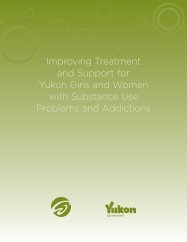
![Women and Alcohol: A women's health resource [2326.26 KB ]](https://img.yumpu.com/22340649/1/190x245/women-and-alcohol-a-womens-health-resource-232626-kb-.jpg?quality=85)
